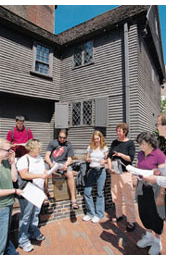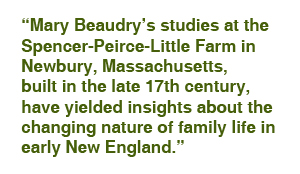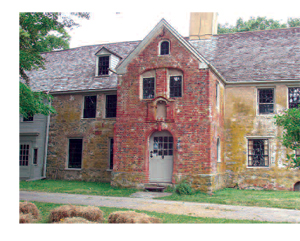Bringing the Past to Life
 Mary Beaudry: Digging Up Dirt on New England Families Mary Beaudry: Digging Up Dirt on New England Families
“I’m not a scientist,” says BU archaeologist Mary Beaudry, “but I use what scientists can tell me.” Much of Beaudry’s research focuses on the lives of New England families, from the first European settlers to the early 20th century. By combining information from historical documents and artifacts with data provided by biologists who study pollen, plant remains, and even insects, she is filling out the picture of how people in New England lived. “There are a lot of hidden histories,” she says, “and by doing the background research you can meet new people.”
 Beaudry has excavated for over a decade at the Spencer-Peirce-Little Farm in Newbury, Massachusetts, originally built circa 1690. Her research has provided insights into the changing nature of family medicine in early New England. She found pollen and plant remains from local herbs in deposits from the 18th century, but she unearthed patent medicine bottles in 19th-century deposits, indicating that families had abandoned home-grown medicine in favor of store-bought preparations. “Apparently someone was very concerned about their hair, because we found a lot of hair restorers,” Beaudry says. Beaudry has excavated for over a decade at the Spencer-Peirce-Little Farm in Newbury, Massachusetts, originally built circa 1690. Her research has provided insights into the changing nature of family medicine in early New England. She found pollen and plant remains from local herbs in deposits from the 18th century, but she unearthed patent medicine bottles in 19th-century deposits, indicating that families had abandoned home-grown medicine in favor of store-bought preparations. “Apparently someone was very concerned about their hair, because we found a lot of hair restorers,” Beaudry says.
 Combining historical records and scientific analysis also helps Beaudry understand how families used the resources of the farm and surrounding countryside. When she and her crew found bones and plant remains at the base of a cellar stairwell that had been blocked by renovations, they conjectured that the finds might be the remains of a dinner given by one of the home’s owners. Because they knew from historical records when the cellar was rebuilt, they could date the remains to 1788. Since some of the bones were from young suckling pigs, which can only be butchered in the spring, they were able to identify the season. Finds of pigeons and wild plants told them that the homeowners gathered food from the surrounding countryside in addition to what they grew on the farm. Combining historical records and scientific analysis also helps Beaudry understand how families used the resources of the farm and surrounding countryside. When she and her crew found bones and plant remains at the base of a cellar stairwell that had been blocked by renovations, they conjectured that the finds might be the remains of a dinner given by one of the home’s owners. Because they knew from historical records when the cellar was rebuilt, they could date the remains to 1788. Since some of the bones were from young suckling pigs, which can only be butchered in the spring, they were able to identify the season. Finds of pigeons and wild plants told them that the homeowners gathered food from the surrounding countryside in addition to what they grew on the farm.
The Spencer-Peirce-Little excavations explored farm life, but Beaudry also studies urban archaeology. She’s excavated boarding houses in Lowell where textile factory workers lived and is currently writing a book on the archaeology of Boston, much of it based on discoveries made by the city archaeologist (one of Beaudry’s former students) during the “Big Dig,” Boston’s two-decade-long highway/ tunnel project. In one instance historical records indicate that a brothel madam married a homeopathic doctor, a fact supported by finds of huge hypodermic needles found at the site. “Cities,” she notes, “are places where people always find interesting ways to get by.”
For more information, see www.bu.edu/archaeology/faculty/beaudry.htm.
Read about Mary Beaudry's most recent dig - the remains of a 19th-century African-American family home on Beacon Hill.
— by Trina Arpin |






 Mary Beaudry: Digging Up Dirt on New England Families
Mary Beaudry: Digging Up Dirt on New England Families  Beaudry has excavated for over a decade at the Spencer-Peirce-Little Farm in Newbury, Massachusetts, originally built circa 1690. Her research has provided insights into the changing nature of family medicine in early New England. She found pollen and plant remains from local herbs in deposits from the 18th century, but she unearthed patent medicine bottles in 19th-century deposits, indicating that families had abandoned home-grown medicine in favor of store-bought preparations. “Apparently someone was very concerned about their hair, because we found a lot of hair restorers,” Beaudry says.
Beaudry has excavated for over a decade at the Spencer-Peirce-Little Farm in Newbury, Massachusetts, originally built circa 1690. Her research has provided insights into the changing nature of family medicine in early New England. She found pollen and plant remains from local herbs in deposits from the 18th century, but she unearthed patent medicine bottles in 19th-century deposits, indicating that families had abandoned home-grown medicine in favor of store-bought preparations. “Apparently someone was very concerned about their hair, because we found a lot of hair restorers,” Beaudry says. Combining historical records and scientific analysis also helps Beaudry understand how families used the resources of the farm and surrounding countryside. When she and her crew found bones and plant remains at the base of a cellar stairwell that had been blocked by renovations, they conjectured that the finds might be the remains of a dinner given by one of the home’s owners. Because they knew from historical records when the cellar was rebuilt, they could date the remains to 1788. Since some of the bones were from young suckling pigs, which can only be butchered in the spring, they were able to identify the season. Finds of pigeons and wild plants told them that the homeowners gathered food from the surrounding countryside in addition to what they grew on the farm.
Combining historical records and scientific analysis also helps Beaudry understand how families used the resources of the farm and surrounding countryside. When she and her crew found bones and plant remains at the base of a cellar stairwell that had been blocked by renovations, they conjectured that the finds might be the remains of a dinner given by one of the home’s owners. Because they knew from historical records when the cellar was rebuilt, they could date the remains to 1788. Since some of the bones were from young suckling pigs, which can only be butchered in the spring, they were able to identify the season. Finds of pigeons and wild plants told them that the homeowners gathered food from the surrounding countryside in addition to what they grew on the farm.